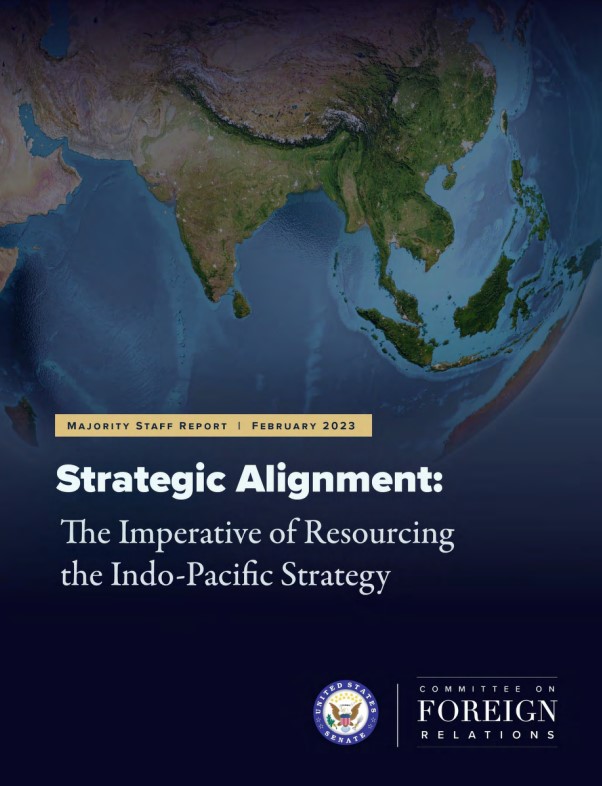
1. Adequately Resource the Indo-Pacific Strategy:
- The Administration must significantly increase funding for diplomatic and development agencies across the U.S. government and dedicate a larger portion of the Department of State operating budget and U.S. foreign assistance to advance priorities in the Indo-Pacific.
- The Administration must also incentivize U.S. agencies to increase grants, loans, and other financing programs in the Indo-Pacific while more effectively leveraging International Financial Institution (IFI) investments.
2. Cultivate Congress as a Key Partner:
- Congress should be made an active partner to ensure sufficient allocation of resources to the Indo-Pacific, to provide new authorities if and when needed, and to engage in effective oversight.
- The Administration should provide Congress with a full, detailed, and prioritized list of its plans for implementing the IPS, updated as necessary, as well as a list of designated officials responsible for implementing the IPS.
3. Advance Economic Integration:
- The IPS must include a substantive and action-oriented economic agenda that is commensurate with U.S. interests and responsive to our allies’ and partners’ calls for increased U.S. economic engagement.
4. Democracy and Human Rights:
- The Administration should make advancing human rights and democracy, which are vital to long-term stability and prosperity, core tenants of the IPS. The Administration must advance these principles throughout the diverse contexts across the Indo-Pacific and demonstrate U.S. commitment to their future importance in the region.
5. Security and Non-Security Efforts:
- The Administration must clarify non-military agencies’ roles in security issues and strengthening our deterrence capabilities. While it is important to maintain and deepen U.S. security ties with regional partners, these security efforts must be balanced with the unique authorities granted to the Department of State, USAID, and our economic agencies, which are vital to advancing our diplomatic and developmental engagement in the region.
6. Expand Investment in Public Diplomacy Efforts:
- To advance our values in the Indo-Pacific, the U.S. must leverage its comparative advantage by expanding investment in public diplomacy and people-to-people ties. The U.S. must also improve our ability to counter disinformation, misinformation, and propaganda.
7. Prioritize Strategic Investments:
- The U.S. and our partners must strive to provide alternative financing and economic development projects to compete with the PRC’s Belt and Road Initiative and the Digital Silk Road.
- The U.S. should not seek to match every investment by the PRC, but should instead prioritize projects rooted in our interests, taking into account strategic locations and sectors including clean energy, transportation and shipping infrastructure, telecommunications and digital investments.
8. Deepen Engagements with Allies and Partners:
- The Administration must deepen engagement with the United States’ network of allies and partners across the region. This includes making the U.S.-Japan-Republic of Korea (ROK) trilateral cooperation more meaningful and resilient; continuing our Pacific Partnership Strategy by prioritizing commitments related to climate change resilience; routinizing the Quad; bolstering U.S.-ASEAN bilateral and institutional ties; advancing AUKUS and the renewal of the Compacts of Free Association (COFA); and encouraging a stronger democratic India.
[출처] SFRC Chairman Menendez Publishes New Report Calling for Ambitious Funding of Diplomacy, Development in Indo-Pacific / Committee on Foreign Relations
목차
Title page
Contents
Letter of Transmittal 3
Executive Summary 4
Key Recommendations 4
Background 7
Realizing the Indo-Pacific Strategy 10
Adequately Resource the Indo-Pacific Strategy 10
Advance U.S. Leadership on Trade and Economic Integration 13
Promote Democracy and Human Rights 17
Bolster Deterrence through Security and Non-Security Efforts 18
Invest in Public Diplomacy Efforts and Expand People-to-People Ties 22
Deepen Engagements with Allies and Partners 25
Conclusion 30
Table 1. USAID Overseas Presence in the Indo-Pacific Region as compared to other Regions 44
Table 2. VOA Total Programming Including Division and Overseas Bureaus Funding by Region, FY2013 - FY2022 45
Table 3. USAGM Regional Broadcaster Total Funding, FY2011 - FY2022 46
Figure 1. U.S. Foreign Assistance to the Indo-Pacific 31
Figure 2. U.S. Foreign Assistance to the Indo-Pacific Region as Compared to Other Regions 32
Figure 3. Department of State Overseas Programs and Public Diplomacy Funding Allocations for the Indo-Pacific, FY2014 Actual - FY2023 Request 33
Figure 4. Department of State Overseas Programs and Public Diplomacy Funding Allocations for the Indo-Pacific and Other World Regions, FY2014 Actual - FY2023 Request 34
Figure 5. DFC and OPIC: New Commitments iin the Indo-Pacific and Other Regions, FY2011 - FY2021 35
Figure 6. USTDA: Funds Obligated in the Indo-Pacific and Other Regions, FY2011 - FY2022 36
Figure 7. Millennium Challenge Corporation Compacts in the Indo-Pacific Region 37
Figure 8. Export-Import Bank: Value of Authorized Transactions in the Indo-Pacific and Other Regions, FY2011 - FY2021 38
Figure 9. Peace Corps Volunteers, Indo-Pacific Region 39
Figure 10. USAID Overseas Presence 40
Figure 11. VOA Total Programming Including Division and Overseas Bureaus Funding by Region, FY2013 - FY2022 41
Figure 12. USAGM Regional Broadcaster Total Funding, FY2011 - FY2022 42
Figure 13. Indo-Pacific Students Studying in the U.S. and U.S. Students Studying in Indo-Pacific Region 43
제목 페이지
내용물
약어 및 두문자어 5
요약 7
소개: 제조업과 미국의 미래 8
고급 제조를 위한 비전, 목표, 목표 및 권장 사항 9
목표, 목표 및 권장 사항 10
목표 1. 첨단 제조 기술 개발 및 구현 12
목표 1.1. 탈탄소화를 지원하기 위한 깨끗하고 지속 가능한 제조 활성화 12
목표 1.2. 마이크로일렉트로닉스 및 반도체용 제조 가속화 13
목표 1.3. 바이오경제를 지원하는 첨단 제조 구현 14
목표 1.4. 혁신소재 및 공정기술 개발 15
목표 1.5. 스마트 제조의 미래를 이끌다 16
목표 2. 첨단 제조 인력 육성 17
목표 2.1. 첨단 제조 인재 풀 확대 및 다양화 18
목표 2.2. 고급 제조 교육 및 훈련 개발, 확장 및 촉진 19
목표 2.3. 고용주와 교육 기관 간의 연결 강화 20
목표 3. 제조 공급망에 탄력성 구축 20
목표 3.1. 공급망 상호 연결 강화 21
목표 3.2. 제조 공급망 취약성을 줄이기 위한 노력 확대 21
목표 3.3. 첨단 제조 생태계 강화 및 활성화 22
추가 기관 간 기여자 24
부록 A. 에이전시 참여 및 지표 25
부록 B. 2018 전략 계획의 목표 달성 과정 27
부록 C. 자세한 권장 사항 33


